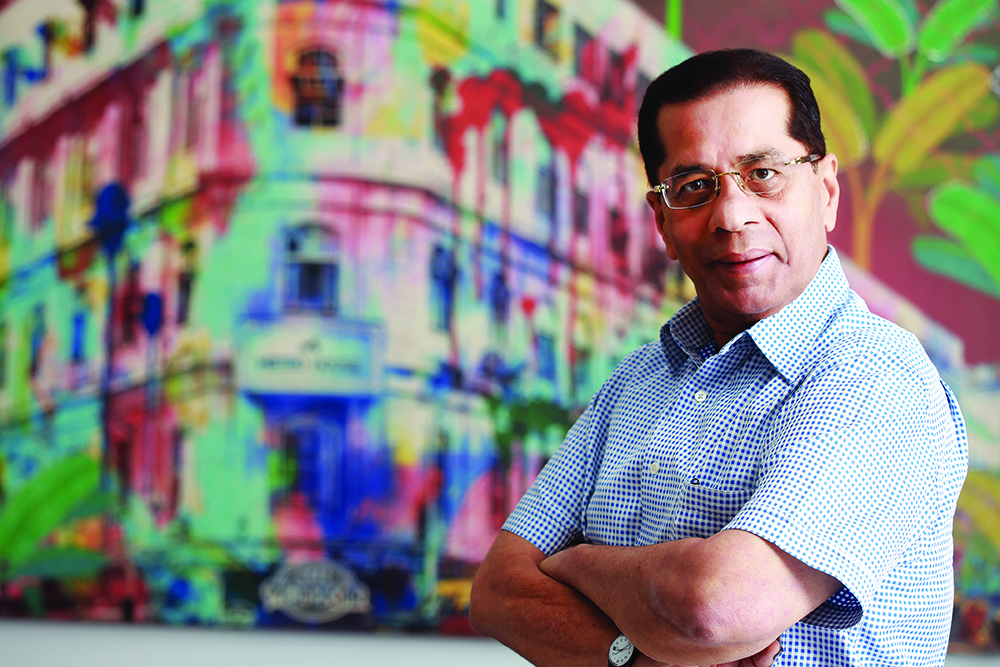 Rafique A. Malik, Chairman and Managing Director of Metro Shoes – the largest national chain of fashion footwear and accessories in India-has turned the brand from a single store operation to a robust company. Metro Shoes recorded a turnover of over `841 crores (sales) in 2014-15. Today, it boasts of a chain of over 290 showrooms across 86 cities.
Rafique A. Malik, Chairman and Managing Director of Metro Shoes – the largest national chain of fashion footwear and accessories in India-has turned the brand from a single store operation to a robust company. Metro Shoes recorded a turnover of over `841 crores (sales) in 2014-15. Today, it boasts of a chain of over 290 showrooms across 86 cities.
Malik’s a key member on the COUNCIL for FOOTWEAR LEATHER & ACCESSORIES and is passionate about upgrading the footwear Industry in India. A self-made man, he has established a benchmark for successful retailing in India. Bringing to the table over 40 years of retail experience, is a graduate of Harvard Business School, he is also the Chairman of AIFMRA (All India Footwear Manufacturers and Retailers Association), is on the advisory board of the Retailers Association of India, member on the CII National Committee for Retailing and a member of the World President’s Organization.
Malik Shares his candid views on the industry…
Share an overview of Indian footwear Industry.
The Indian footwear industry forms the major portion of Indian leather industry and is the second largest producer of footwear in the world. The footwear industry is pegged at around Rs.38,000 crores. The footwear industry is dominated by the men’s segment which comprises 55% of the market. The women’s and Kid’s footwear constitute 35% and 10% of the market respectively, whereas globally women’s footwear constitutes 55% of the market.
The industry has sufficient capacity in tanning and thereby regular availability of leather and non-leather materials and other components. The labour is available which is mainly from socially and economically backward areas and women constitute 30%. The labour should be provided with training for skill development and amenities so that good quality labour will be attracted to this industry. The industry is also adopting to newer technologies for designs and capacity building. A good network of distributors and retailers is in place. The government should support the industry with reduction in taxes and availability of finance at lower rates so that enough investment can be made to realise true potentials of the industry.
Knowing the potential of the Indian Footwear Industry, many international brands have entered in India. Today, there already exist over 200 international fashion brands in India with more than a quarter of these operating predominantly in the footwear and accessories category. Until recently, the footwear was considered as item people would buy only after checking and trial. However, the Ecommerce (e-com) and Mobile commerce (m-com) have changed the scenario. The online channel has further emerged as an important route to reaching the consumers especially in the tier II and III cities where demand exists but there is low accessibility due to inadequate distribution network.
THE GOVERNMENT SHOULD SUPPORT THE INDUSTRY WITH REDUCTION IN TAXES AND AVAILABILITY OF FINANCE AT LOWER RATES SO THAT ENOUGH INVESTMENT CAN BE MADE TO REALISE TRUE POTENTIALS OF THE INDUSTRY.
Could you explain CFLA’s objective’s in simple terms?
The Council for Footwear, Leather and Accessories (CLFA) is formed with the active participation of the major footwear companies and DIPP to bring together all the associations working for the development of footwear industry, so that a common agenda can be implemented with the help from the Government. The CFLA is an autonomous body, for representing and provide help in addressing the concerns for the development of Indian Leather & Footwear industry.
The main objectives of the Council include creation of a unified body of the fragmented associations operating in the sector and to plan a strategy for the growth of the Footwear Industry with major emphasis on MAKE IN INDIA initiative of the Government.
What are the major challenges for the Council?
Most the Footwear Industry is unorganised and it is in the interest of the industry to help this sector to improve their manufacturing and sourcing capabilities with good infrastructure, easy availability of raw materials and components, training a large number of labour.
The Footwear industry is affected by high taxation; both excise duty and VAT. It has resulted in lack of new investments into domestic manufacture of footwear and there has been a rapid increase in imports. There is a need to incentivize the existing footwear manufacturing and retailing industry which will inspire and attract new investments and create large scale job opportunities in the sector. The Council is,therefore,focussing on reduction in tax burden with merit rate under GST regime to provide growth momentum.
What are the key factors that determine the success of CFLA?
A major success of CFLA will be in bringing together all major footwear industry players and associations and represent the concerns of the industry in unified voice before the government. As CFLA has been established under the government support, it will serve as an important link between the domestic footwear players and the Government to take up theissues faced by the footwear industry such as advocacy, infrastructural development, mass training programs for development of skills both for manufacturing and retail and financial support to the industry.
The success of CFLA will be measured in terms of creation of environment which would be conducive for growth and would enable utilise true potentials of the Industry. The target would be to achieve growth rate from existing 12% to 20% in the next three years, increasing exports and reducing imports.
KNOWING THE POTENTIAL OF THE INDIAN FOOTWEAR INDUSTRY, MANY INTERNATIONAL BRANDS HAVE ENTERED IN INDIA
What is your present priority as a CFLA member and how do they differ from AIFMRA?
Although, most of the objectives of both CLFA and AIFMRA are similar, the CFLA has wider agenda and representations from a diverse footwear players and associations. The AIFMRA is meant mainly for Footwear manufacturers and retailers whereas CFLA is meant for the entire domestic leather industry including footwear and accessories.
It needs more time and efforts as the CLFA would be major vehicle of growth of leather and footwear industry in India. It requires involvement in major policy decision, with constant interaction with the government. The priority for CFLA to be an enabler for the development of the Industry to attain its optimum level of potentials in the Indian economy.
India is being recognised as one of the manufacturing hub. Your view?
India is a good manufacturing base for footwear and is the 2nd largest footwear producing country (after China) and the 3rd largest consuming country (after U.S.A. and China). Indian Leather Industry is one of the oldest traditional industries divided into several components like tanning, footwear and leather products including garments. Indian footwear industry is the engine of growth for the Indian Leather Industry.
The industry is highly outmoded and antiquated. Hence, there is a vast untapped potential for large scale domestic manufacture. We appreciate that the “MAKE IN INDIA” program of the Government has identified leather goods and Footwear as a focus sector and seeks to attract new investments for domestic manufacture of footwear. The National Manufacturing Competitiveness Council (NMCC) has also identified footwear as a “focus” industry in terms of untapped potential, has noted “high rates of indirect tax” as a key challenge faced by the industry. We would like to create at least 4 to5 Global brands which will enhance BRAND INDIA in the world.
THE MAIN OBJECTIVES OF THE COUNCIL INCLUDE CREATION OF A UNIFIED BODY OF THE FRAGMENTED ASSOCIATIONS OPERATING IN THE SECTOR….
What capacities and efforts is the council investing in manufacturing & retail sector ?
The CFLA is encouraging proper infrastructure and investment in both manufacture and retail by reducing tax burden. The Council is making efforts to make the industry cost efficient and competitive. The Council is encouraging export and reducingimports substantially to increase the share of the industry in the world.
In manufacturing, the focus would be on regular supply of leather and components, skill development, technology upgradation, branding and marketing. In retail the focus will be on availability of good retail spaces at competitive prices, skill development and efficient payment options to the customers and providing industry status.
What are the biggest risks for Indian footwear industry as of now?
A large portion of demand for footwear and other leather products is being met from imports as the domestic industry is failing to meet the demand from increasingly aspirational Indian consumers. Lower cost of raw materials and labour in other developing countries, and favourable import regime are resulting into significant flight of capital, production and employment to low cost countries. We are already importing around 170 million pairs of footwear from China and Vietnam. These imports are grossly undervalued impacting revenue collection and killing the domestic industry. An urgent need is to stop these malpractices and enforce transparency which will help the domestic manufacture in building capacities and procuring materials from proper channels at competitive prices.
There are very few footwear skill / training institutes in the country. The Industry is facing shortage of skilled craftsmen for good quality of footwear at competitive prices. R & D facilities are also required to be developed.
What do you think about the capabilities of workforce industry?
The Industry is facing issues in attracting good talent and craftsmen. The major workforce is socially backward and poor, 30% of them are women. The workforce should be given proper training and skill development would play an important role. The provision of basic amenities with competitive compensation would ensure availability of the workforce to the Industry. This is one more area where CLFA can play an important role.
In the past we haven’t seen any stress in the domestic leather/footwear market by any councils. Would CLFA invest any efforts in the domestic sector?
As mentioned earlier, our focus would be to encourage export and reduce imports. Our role would be to make the products globally competitive with focus on quality and scale – to create ‘Brand India’. The imports would be restricted only where we will be doing a substantial value addition rather than only importing footwear. The Council will be taking special initiatives to address this.
What measures would the council suggest for enhancing competitiveness of footwear industry for inviting investments, both FDI as well internal, in the sector?
Apart for reduction in high taxation, we expect labour market reforms, development of infrastructure, encouragement for technology upgradation and availability of credit facilities at competitive rates for increasing investment in the sector.
Would you like to give some specific advice to the retail industry?
Indian retail market has lot of potentials and possibilities. The market is very challenging and promising. India’s strong fundamentals supported by rising incomes, favourable demographics, entry of foreign players, and increasing urbanisation offer immense scope of retail expansion. While expanding network of stores, a quality of staff and good back-end processes should be ensured to sustain the growth. You should also be selective in deciding the locations and do proper viability analysis.
What are the biggest strengths you think Indian Leather and finished products manufactures and exporters bring in changing global economic conditions to stay in global market?
The biggest strength of the Indian Leather and Footwear manufacturers is reliable supply of good quality leather and non-leather materials and a relatively low cost of labour. India is considered as low cost quality Footwear and leather products exporter.
What should be the future plans for Indian Footwear industry in world map?
The future plan of the footwear industry is to strive for a globally competitive industry and apart from the needs of the increasing domestic market, increase exports and take substantial share of the Global Market.










